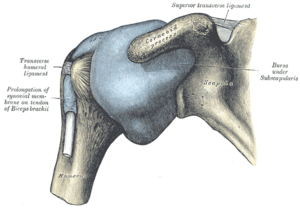Shoulder
| Shoulder | |
|---|---|
 |
|

Capsule of shoulder-joint (distended). Anterior aspect.
|
|
| Details | |
| Identifiers | |
| Latin | articulatio humeri |
| MeSH | D012782 |
| Dorlands /Elsevier |
12161240 |
| TA | A01.1.00.020 |
| FMA | 23217 |
|
Anatomical terminology
[]
|
|
The human shoulder is made up of three bones: the clavicle (collarbone), the scapula (shoulder blade), and the humerus (upper arm bone) as well as associated muscles, ligaments and tendons. The articulations between the bones of the shoulder make up the shoulder joints. The shoulder joint also known as the glenohumeral joint, is the major joint of the shoulder, but can more broadly include the acromioclavicular joint. In human anatomy, the shoulder joint comprises the part of the body where the humerus attaches to the scapula, the head sitting in the glenoid cavity. The shoulder is the group of structures in the region of the joint.
The shoulder joint (also known as the glenohumeral joint) is the main joint of the shoulder. It is a ball and socket joint that allows the arm to rotate in a circular fashion or to hinge out and up away from the body. The capsule is a soft tissue envelope that encircles the glenohumeral joint and attaches to the scapula, humerus, and head of the biceps. It is lined by a thin, smooth synovial membrane. The rotator cuff is a group of four muscles that surround the shoulder joint and contribute to the shoulder's stability. The muscles of the rotator cuff are supraspinatus, subscapularis, infraspinatus, and teres minor. The cuff adheres to the glenohumeral capsule and attaches to the humeral head
...
Wikipedia
